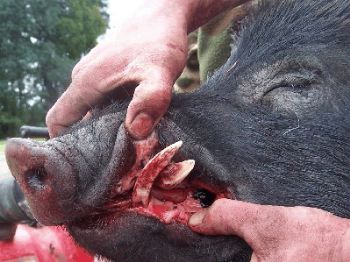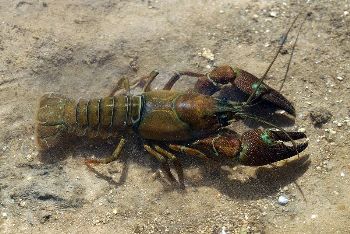by Larry
October, 2014Oink vs. Clack: Intercontinental Invaders!
Yet turnabout is fair play, right? American signal crawfish, native to the Pacific Northwest, are these days growing in population and even in size (at times getting up to 10-12 inches in length, rivaling the lobster as potential table fare) in Europe and are threatening native trout species in the United Kingdom, especially Scotland. Considered a scourge there, they are banned and must be killed on sight. Eating these delicacies is against Scottish law. They are replicating themselves in prodigious numbers, partly because they do not require engagement between the genders to reproduce. Digging trenches up to a few feet long in which to lay their eggs, they are undermining the banks of European rivers and small streams. They eat everything the trout usually do, yet, unlike the fish, can spread into new territories by merely going cross-country. Just as the combined efforts of government agents and hunters are not offsetting the natural breeding success of wild porkers, so too all the new laws and eradication attempts by Scottish authorities have not held the American signal crawdads in check.
Other folks have resigned themselves to the encroachments of various aliens and sought to at least benefit from them, for instance, encouraging people to feast on lionfish, now infesting Caribbean and U.S. East Coast waters but native to the South Pacific and Indian Oceans. Yet the Scots will have none of it when it comes to invasive crawfish. Their streams are now sometimes so teeming with them that it's as if one could walk on water, so thickly do the crawdads fill the available watercourses. Yet fishermen inadvertently catching a few hundred of these interlopers in their nets are required to crush them to death, then simply discard the crustacean carcasses. Where will such native vs. invasive species wars end? Who knows, but as the ease of modern accidental transport combines with a global warming transformation of the environment, it appears that many thousands of once local creatures will have a second chance to thrive in new ways, wastelands, or waters. Nor is it by any means certain in the age-old rivalry between beings with backbones and invertebrates that those closer to us in the evolutionary scheme of things will triumph. As with the Scottish waters victory to date of crawdads over trout, across a radically changing planet those with a more primitive sort of legacy may find it easier in many places to gain hegemony. At least in the New World, though, lionfish and wild pigs alike can help us claim, zebra mussels notwithstanding, for yet awhile, vertebrates rule! Primary sources: American Intruder Lurks in Scottish Streams, Clawed and Hungry. Ari Shapiro on NPR, October 12, 2014; Coping with Feral Hogs: Frequently Asked Questions-Wild Pigs. Texas A&M AgriLife Extension, last updated January, 2012. |

